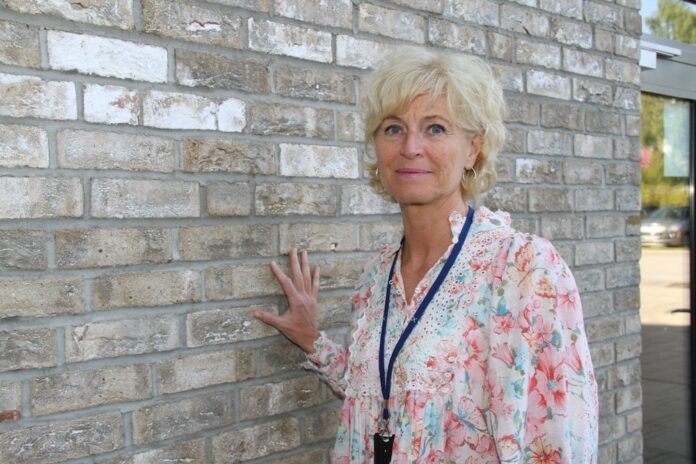Nkom wants the construction industry to work with mobile operators to improve the signals as operators fear onerous regulation
The Norwegian Communications authority (Nkom) has called for the construction industry and mobile operator to cooperate better to overcome the modern life issues that new buildings are so well insulated that mobile phone coverage is blocked.
The regulator emphasised that commercial players must “take care of themselves” and not wait for the authorities to regulate. “We believe it is best for the players themselves to come up with good solutions together,” said section manager Inger Vollstad at Nkom (above).
It is mainly changes in building regulations that create challenges with mobile coverage in newer buildings. “Modern mobile networks use higher frequencies, and that gives us faster internet. However, it requires more antennas or special systems to function well inside dense, modern buildings. This may explain why mobile coverage disappears in modern buildings even though there has been coverage in the same building with older mobile technology,” said Vollstad.
Operators don’t want coercion
Nkom has prepared a draft guide to help building owners and tenants who struggle with poor coverage in their buildings. This received 18 public comments. In its submission, Telenor said mobile operators should not be held responsible for ensuring mobile signal availability inside buildings. The operator stressed that building design and materials, which operators cannot control, significantly affect signal penetration. Requiring operators to provide indoor coverage would, in Telenor’s view, be both unreasonable and unworkable due to the potentially unpredictable and high costs involved.
Telenor argued that responsibility for indoor infrastructure should remain with building owners, just as it currently is for utilities such as electricity, ventilation, and Wi-Fi. It highlighted that while mobile signals penetrate buildings less effectively than in the past, due to the evolution of construction materials, this should not translate into regulatory obligations for mobile network operators to compensate for signal loss.
Early planning by building developers is seen as essential. Telenor recommended that the final guide should more clearly emphasise the economic benefits of incorporating indoor coverage considerations early in the design process. This would support better outcomes for occupants and avoid costly retrofits.
In terms of technology, Telenor called for more clarity and completeness. It said that the current draft could give the impression that only third parties can provide multi-operator solutions, when in fact the operators themselves also offer such services. According to the operator, the guide does not adequately describe modern solutions such as small cells, which are now widely used for scalable indoor coverage.
Passive systems
Telenor also warned against relying on passive systems that draw on outdoor donor signals via antennas, as these are vulnerable to changes in the surrounding environment, like new building developments, which can degrade signal quality.
The operator said the reuse of existing infrastructure, such as fibre and Cat6a cabling, should also be encouraged to reduce installation costs and complexity. Telenor also questioned the inclusion of Wi-Fi in the draft guide, arguing that if Wi-Fi calling is presented as an alternative.
On the topic of electromagnetic fields (EMF), Telenor told Nkom this should not be a main focus of the guide. They suggest a brief mention, with links to relevant resources, would be more appropriate. Similarly, the operator believed the section on Nødnett (Norway’s emergency communication network) should be more narrowly focused. It recommended referencing current procedures, under which building owners can apply for and fund indoor emergency network coverage, rather than expanding the topic in multiple sections.
Telenor also called for greater focus on operational and security aspects of indoor mobile systems. In particular, they suggest the guide should address how responsibilities for operations and response times should be defined, especially in critical use cases. The implications of the EU NIS2 directive on the choice of technology and service providers should also be considered.
The operator disagreed with the suggestion that dedicated electricity subscriptions were preferable. They argue that, like other building infrastructure, power for indoor mobile systems should normally be the responsibility of the building owner. Requiring separate metering and infrastructure would increase costs with limited benefit, especially since power usage is largely fixed once systems are installed.
So Telenor supported Nkom’s initiative to develop a guide for indoor mobile coverage but found the current draft too incomplete to provide detailed feedback.
Sort it out
Despite Telenor’s somewhat cool reception of the guide, Nkom said some of the feedback it had received was that there are often discussions between mobile operators and developers, those who will run a building and tenants about who is responsible for ensuring good enough mobile coverage in the building. “It becomes a game of tug-of-war,” said Vollstad.
She therefore emphasised that it is inappropriate for Nkom to issue orders. “We aim to process the hearing recordings so that an updated version of the guide becomes available, but it will take some time. In the long term, we also do not rule out that Nkom will take part in the necessary dialogue between the mobile providers and the owner or user of the building,” she said.
Some of the comments on the advisory, which has now been released for public consultation, are that some players are sitting on the fence and waiting for a solution from Nkom. “We believe it is not right that those who rent office space are left with an issue they may not have thought about. Therefore, it is important for us to make this challenge known so that tenants and property managers can demand good coverage in their leases and operating agreements,” said Vollstad.
“No one wants to rent or operate a building that lacks good mobile coverage,” she said. If you are going to build something new, you should include mobile coverage in your offer. If you are going to rent or sublet a building that already has poor indoor mobile coverage, you should let the mobile companies compete for you as a customer.”




